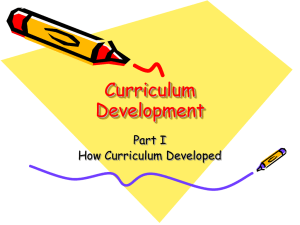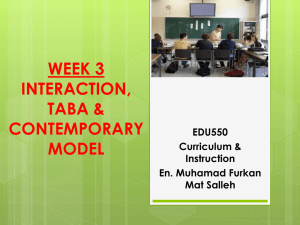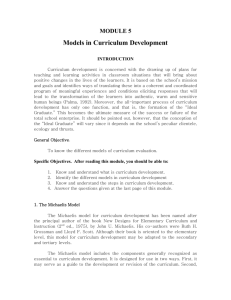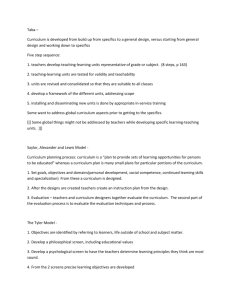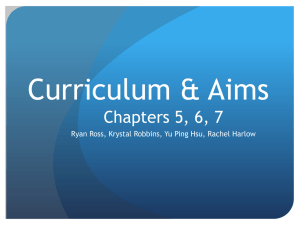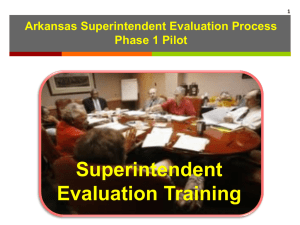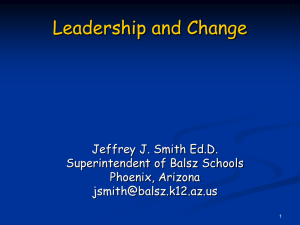Chapters 3-5
advertisement
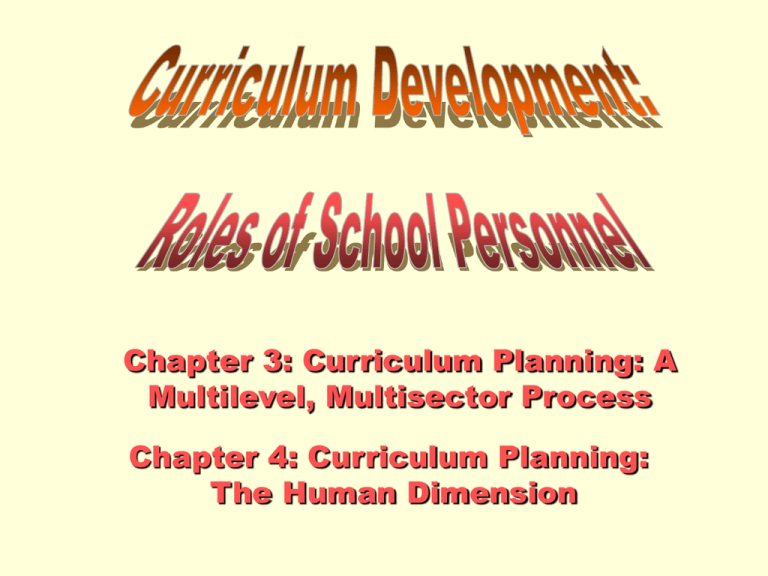
Chapter 3: Curriculum Planning: A Multilevel, Multisector Process Chapter 4: Curriculum Planning: The Human Dimension Sectors of Planning Classroom Team School District State Region Nation World Sectors of Planning Classroom Team School District State Region Nation World Curriculum Planning: A Multilevel, Multisector Process The five levels of curriculum planning: The state The district The school The department or team The classroom Each level of planning is subject to the authority of the one above it. However, classroom planning is still considered the most important. The sectors of curriculum planning: The world The nation The region The concept of sectors differs from levels in that there is no hierarchy. World Nation Region Levels and Sectors of Planning State School District School Team/Grade/Department Classroom The sectors of planning: Where are decisions made? Classroom Team School District State Region Nation World Efforts at the various levels: Classroom – develop yearly plans, develop units of study, enrich the curriculum and remediate learning, establish goals and objectives, evaluate the curriculum and learning. Department / team – content, sequencing, adapting, establishing objectives, selecting resources, determining groupings, evaluating and coordinating. Curriculum leaders begin to emerge at this level. School – develops a vision of quality curriculum, develops programs of study, develops a learning-centered schedule, determines the nature and extent of curriculum integration, aligns the curriculum, monitors and assists in the implementation of the curriculum (support / evaluation / training). Efforts at the various levels: District – Provides the “framework” for which the previous levels (classroom, department, school) must function. Goals and objectives of these subordinate levels must mesh with those established by the district. The district commonly: Develops and implements curriculum related policies Develops goals based on state goals Identifies curriculum requirements and time allocations for each level as well as developing curriculum guides Leads in the selection of instructional materials Develops performance measures Evaluates the curriculum Provides fiscal and other resources Provides training and support Efforts at the various levels: State – accredits, evaluates & monitors programs, disburses state and federal through state moneys, and enforces standards for graduation, develops state-wide standards of philosophy, goals, and objectives. The state commonly: Develops a framework for goals, standards, and requirements Develops tests and other performance measures Provides needed resources to local districts Evaluates the frameworks Efforts at the various levels: Regional, National, and International – Curriculum efforts in these sectors are likely to consist of sharing problems, exchanging practices, reporting research, and gathering information. Principal Grade coordinator/ teacher Teacher Teacher Teacher Pattern I (self-contained grade school) Principal Team Leader/ English Teacher Social Studies Teacher Math Teacher Science Teacher Pattern II (interdisciplinary team at a middle school) Pattern III (two teams at the same grade level) Principal Grade coordinator/ Team I Leader Team I member Team I member Team II member Team II member Team II member Pattern IV (traditional dept. style for a secondary school) Principal Head of English Department English teacher English teacher English teacher English teacher English teacher Principal Faculty Curriculum council Subcommittee Pattern A1 (school level) Principal Faculty Curriculum council Subcommittee Pattern A2 (school level) Total Faculty Principal Total Faculty Community Advisory Council Faculty Curriculum council Student Advisory Committee Subcommittee Pattern A3 (school level) Principal Total Faculty Expanded curriculum committee Subcommittee Pattern A4 (school level) Superintendent Principal District curriculum council Subcommittee Pattern B1 (district level) Community advisory council Superintendent Principal Expanded curriculum council Subcommittee Pattern B2 (district level) Pattern B3 (district level) Curriculum advisory council Area superintendent Director of instruction Superintendent Curriculum coordinating council Assistant Superintendent Area superintendent Director of instruction Area superintendent Area superintendent Director of instruction Director of instruction Director of Instruction Principal Curriculum council Subcommittee Pattern B3 (cont.) Chapter 4 Curriculum Planning: The Human Dimension Objectives: Describe the roles of a) the principal b) the curriculum leader c) the teachers d) the students e) the parents and other citizens in curriculum development Describe the knowledge and skills needed by the curriculum leader. The Cast of Players Role of the Administrator: – – – May serve actively or passively as curriculum leader Curriculum development is doomed to failure without his or her support Success may depend on whether the principal is a “Theory X” or “Theory Y” person Role of Students Provide input by indicating how they perceive a new proposal or program Evaluate teachers’ instruction Degree may depend on variables such as intelligence, motivation, and knowledge of subject matter Role of Citizens in the Community Parents and others serve on advisory committees Parents serve as resource persons and volunteer as aides Local businesses have entered into partnerships with schools by providing expertise, funds, and materials to aide curriculum development State and national efforts have supplemented initiatives to involve the community in school affairs Role of the Teachers Teachers constitute the majority or totality of the membership of curriculum committees and councils Teachers review and initiate proposals, gather data, conduct research, make contact with parents, write and create curriculum materials, evaluate resources, obtain feedback from learners, and evaluate programs. Most teachers feel left out of the decision-making process Role of the Curriculum Leader The curriculum leader may be a member of the faculty or an outsider. This is considered the “extended family”. The curriculum coordinator must be a specialist in the group process, possessing a unique set of skills. Curriculum Leader and Group Process The Change Process Interpersonal Relations Leadership Skills Communication Skills The Change Process Four Variables: 1) 2) 3) 4) Structure Information and control methods People Task Interpersonal Relations Individuals bring their motivations-their personal desires, feelings, or goals, commonly referred to as the “hidden agenda” Individuals in groups often behave differently then their individual behaviors The group itself assumes a personality all its own Leadership Skills Other views: Traits of Leaders: Intelligent Experienced Assertive Articulate Innovative Dynamic Charismatic “Right place and right time” A politician A climber A friend of a person in power Two Approaches: Autocratic Democratic Difficulties with Oral Communication: Members of the group have a difficult time getting to the point. Use fuzzy, imprecise language Select out of discussion the things they want to hear Fail to express themselves Fail to follow an orderly process Discussion is stopped and group votes prematurely Sessions breaks up without closure Communication flow is from leader to member Hostility and disharmony exist within the group Difficulties with Written Communication: The writer cannot realize his impact Excessive in number English is poor Chapter 5: Models for Curriculum Development Part III: Components of the Process CHAPTER 5: Models for Curriculum Development I. Selecting Models Types of Models: – Deductive – proceed from general to specific – Inductive – from specific to general I. Selecting Models Cont. Types of Models – Linear – specific sequence of progress – Non-linear – steps can be skipped, reversed etc. I. Selecting Models Cont. Types of Models – Prescriptive – what ought to be done – Descriptive – simply describes the process II. The Models of Curriculum Development Using the Tyler Model Identification of objectives – Use the learners, society and the subjects to identify the objectives II. The Models of Curriculum Development Using the Tyler Model Screening the Objectives – – Philosophical Screen – which objectives emphasize the values of our democratic society? Psychological Screen – Which objectives are realistic in terms of time and difficulty? II. The Models of Curriculum Development Using the Tyler Model Identification of objectives – After the screening, we are left with “Precise Instructional Objectives” Tyler’s curriculum rationale Source Source Source Student Society Subject Tentative general objectives Screen Philosophy of education Screen Psychology of learning Precise instructional objectives II. The Models of Curriculum Development Using the Tyler Model Expanded Model – After specifying objectives, Tyler speaks to the selection, organization, direction and evaluation of the learning experiences. II. The Models of Curriculum Development Using the Tyler Model Expanded Model – Tyler states that teachers should give attention to learning experiences that will: Develop skill in thinking Be helpful in acquiring information Be helpful in developing social attitudes Be helpful in developing interests Precise instructional objectives Selection of learning experiences Organization of learning experiences Direction of learning experiences Evaluation of learning experiences Tyler’s curriculum rationale (expanded) II. The Models of Curriculum Development Using the Taba Model Taba proposed an inductive, “grassroots” approach in which the curriculum planning begins at the teacher student level. II. The Models of Curriculum Development Using the Taba Model The Taba Model is a 5-step process 1. Produce Pilot Units -An 8-step process for selecting and organizing content and activities Diagnosis of needs Formulation of objectives Selection of content Organization of content Producing pilot units Selection of learning experiences Check for balance and sequence Evaluation Organization of learning activities II. The Models of Curriculum Development Using the Taba Model 2. Testing Experimental Units - teachers test pilot units for validity and “teachability” 3. Revising and Consolidating - Modify for student needs and differences in teaching styles II. The Models of Curriculum Development Using the Taba Model 4. Developing a Framework - examine units for adequacy of scope and sequence 5. Installing and Disseminating New Units - administrators arrange training to make teachers effective in teaching the units II. The Models of Curriculum Development Using the Saylor, Alexander and Lewis Model Model established 4 domains – goals and objectives created within the domains by curriculum planners – recognized the idea that prior political decisions can limit design – – – – Personal Development Social Competence Continued Learning Skills Specialization II. The Models of Curriculum Development Using the Saylor, Alexander and Lewis Model Instructional Modes – Teachers specify objectives and select appropriate strategies II. The Models of Curriculum Development Using the Saylor, Alexander and Lewis Model Evaluation – Determine whether School goals were met Objectives of instruction were met II. The Models of Curriculum Development Using Oliva Model A 12-step linear deductive model Represents a complete model covering: – – – Needs (selection of curriculum) Instruction Evaluation II. The Models of Curriculum Development Using Oliva Model Model can be used: – – – To develop an entire curriculum for a school or a department To focus on programs (1,5 and 12) To focus on instruction (6-11)
